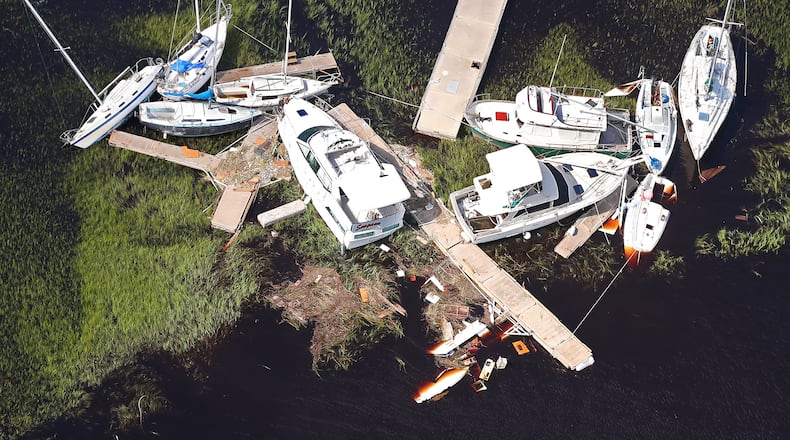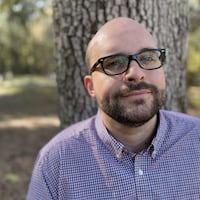After Hurricane Irma finished its assault on coastal Georgia last year, Jeff Adams went to survey the damage on the St. Marys waterfront, a popular tourist pit stop on the way to Cumberland Island. He saw streets flooded and littered with Styrofoam from the bottoms of destroyed docks. The few boats that hadn’t sunk were battered. The smell of diesel fuel, leaking from the cracked vessels, hung the air.
Residents were stunned. Adams? He was versed in research on the vulnerabilities of the Georgia’s 100-mile-long coastline. And he was thankful. “I was amazed it didn’t get us worse,” recalled Adams, who was then the city’s community development director.
A year later, Adams is among numerous officials who weren't surprised to read dire warnings for Georgia — and the entire Southeast — in the climate change report issued last week by 13 federal agencies. The sprawling and detailed document predicts that in the coming decades the coast will be at greater risk of flooding amid rising sea levels and stronger, more frequent hurricanes. It suggests potentially heightened danger of wildfires in the state's northern mountains. It urges communities to steel themselves for myriad issues from increased heat in every corner of Georgia.
The message is clear: Climate change is already hurting the state — and it will only get worse.
The topic, of course, remains fraught politically. President Donald Trump, long a skeptic of the causes underpinning climate change and the scope of its damage, disavowed the report, even though it came from his own administration.
But the science is becoming more accepted. Nearly two-thirds of Republicans and a majority of all Americans now acknowledge climate change, according to a new poll from Monmouth University. A deeper divide in opinion remains over whether the cause is man made.
Credit: ccompton@ajc.com
Credit: ccompton@ajc.com
Regardless, officials and researchers in Georgia have been studying the issue, albeit at times quietly, and taking steps to prepare. They’re often using taxpayer money to do it. That’s been especially true in the past three years, which have been marked by a series of punishing hurricanes and large wildfires in both north and South Georgia. Those events left billions of dollars of damage in their wake and, in the case of the storms, killed seven people.
Researchers with the Georgia Climate Project — founded by the University of Georgia, Georgia Tech and Emory University — are creating a massive public database with their findings in hopes that officials will use the information to drive policy changes.
PHOTOS: Hurricane Michael’s trail of destruction
IN DEPTH: In Southwest Georgia, lives damaged by Hurricane Michael
With work already underway in Georgia, some said the new federal report serves to raise tensions and remind that more must be done, quickly, by all levels of government.
“I feel like we’re doing all we can,” said Jason Buelterman, mayor of Tybee Island, which some projections suggest could be largely underwater in 80 years. “There’s nothing we can do unless Washington and the world addresses the issue.”
Grim predictions
The most clearly articulated danger for Georgia in the report — written by researchers with federal departments of agriculture, commerce and others, including NASA — is to historic communities along the coast.
High-tide flooding has increased since the 1960s in coastal cities in the Southeast, with record years now routine. In Savannah, 2016 saw a record 38 days of flooding problems. Back in 1960, buoys at nearby Fort Pulaski recorded only a few days a year of high-tide flooding. “Without significant adaptation measures,” the researchers wrote, “these regions are projected to experience daily high-tide flooding by the end of the century.”
This, along with more powerful storms, jeopardizes homes, infrastructure and Savannah’s largely tourism-based economy. And, of course, the report only lists Savannah as an example. Other cities on the coastline face the same concerns.
The report also predicts the Southeast could see more wildfires, citing the drought of 2016, which contributed to the most destructive blazes the southern Appalachian Mountains have seen in a century. Those fires burned tens of thousands of acres across the Chattahoochee National Forest.
Credit: ccompton@ajc.com
Credit: ccompton@ajc.com
The western U.S. sees the most wildfires, the document notes, but the Southeast has the largest area of so-called prescribed burns, blazes set intentionally to keep the forests healthy. “In the future, rising temperatures and increases in the duration and intensity of drought are expected to increase wildfire occurrence and also reduce the effectiveness of prescribed fire,” the researchers wrote.
Forests across the state could face the same risks as northern Georgia, depending on how droughts and projected increases in rain shake out. Other estimates, such as from the International Journal of Wildland Fire, suggest southeast Georgia could see greater threats than north Georgia from wildfire by 2070, according to a data in recent New York Times report. The Okefenokee Swamp has already been scarred by large, destructive fires in recent years.
Taken to Heart
The state of Georgia has taken initial steps to prepare for climate change, including developing long-term plans to help coastal communities adapt, but much of the action so far is at the local level, where the danger is harder to ignore.
“From the city’s perspective,” Nick Deffley, Savannah’s sustainability director, said, “we know it is an issue that’s only going to be increasing.”
At the moment, Savannah is working with Chatham County to install a series of sea-level censors around the city and on barrier islands. The goal of the project, funded by a grant from Georgia Tech, is to help the county with storm response in real time. Deffley said they’ll be monitoring canals, and upgrades are regularly being made to the storm water infrastructure.
In St. Marys, City Manager John Holman said, in the last year and a half alone, the city has invested $2.1 million in studies and infrastructure improvements. Workers are putting in retention ponds, permeable paving material in parking areas and six gates to keep tide from overwhelming the storm water system.
“We’ve taken to heart the recommendations,” Holman said. “We’re looking out at least 50 to 100 years.”
Up on Tybee, recent years have seen state-funded projects to build up dunes in hopes of combating storm surge. In 2019, the Georgia Department of Transportation is planning to raise parts of the causeway leading to the island. The road regularly gets flooded and must be shut down, leaving residents marooned. But the mayor pointed out the improvements will only protect from day-to-day tide problems; the highway is expected to still get overwhelmed during hurricanes.
Credit: Stephen B. Morton
Credit: Stephen B. Morton
He said the community has also applied for federal funding to lift 65 houses. The grant would cover 85 percent of the costs, homeowners would handle the rest.
Like hurricanes of the past three years did for the coast, the 2016 wildfires served as sobering reminders farther north. “It really brought into focus that we need to do more, that it’s more urgent,” said Steven Bekkerus, a Georgia-based spokesman for the U.S. Forest Service.
To combat the dangers, the service works with state and local partners on myriad programs and initiatives to raise awareness about the ease with which a huge fire can be started. It also does regular controlled burns, such as one in April at Tallulah Gorge State Park, and works to keep “hazardous fuel,” such as fallen leaves and wood debris, off the floor of the forests.
Challenges
Time and again, experts and officials said the greatest challenges is changing the way Georgians — and Americans — respond to environmental peril. Up to now, the idea has been your community gets damaged, then you clean up and prepare for the next hit.
“We need to do something, and we’ve got to do it now,” said Adams, the former community development director in St. Marys, who now works in Oregon. He said he enjoyed working in St. Marys because, even before Hurricane Irma tore up downtown, people in the city and Camden County governments understood and accepted the dangers they faced.
Credit: Curtis Compton
Credit: Curtis Compton
But local governments only have so much money to spend on this. They need more consistent federal funding and support from the state, Adams said.
It’s yet to be seen what approach governor-elect Brian Kemp’s administration will take. His office said it hasn’t yet reviewed the new federal report.
On the campaign trail, he largely agreed with fellow Republican Gov. Nathan Deal’s belief that it should be up to local authorities to adopt development restrictions and take other preventive measures. Kemp said: a “one-size-fits-all approach from state government is not the answer.” His policy rolled out in the campaign didn’t include any detailed plans to restore shoreline or take other direct preventive measures.
Patricia Yager, a UGA professor involved in the Georgia Climate Project, said the organization’s target audience isn’t top government leaders — it’s municipal and county governments who don’t need approval from on high to get to work.
“A lot of people are moving forward on this issue regardless of what’s happening at the highest level,” she said. “You’re seeing even very conservative towns in South Georgia respond.”
Just this week, she was excited about how people across the state are responding. The Georgia Climate Project welcomed several new academic partners: Agnes Scott College, Georgia Southern University, Spelman College and the University of North Georgia.
As a professor, she’s even seen a shift in students’ attitudes.
About 10 years ago, students were becoming less incredulous about climate change, but they were still asking how it would affect them personally. Now, few question the science, and the question they ask most frequently is: how can we fix it?
Staff writer Greg Bluestein contributed reporting.
About the Author
Keep Reading
The Latest
Featured









